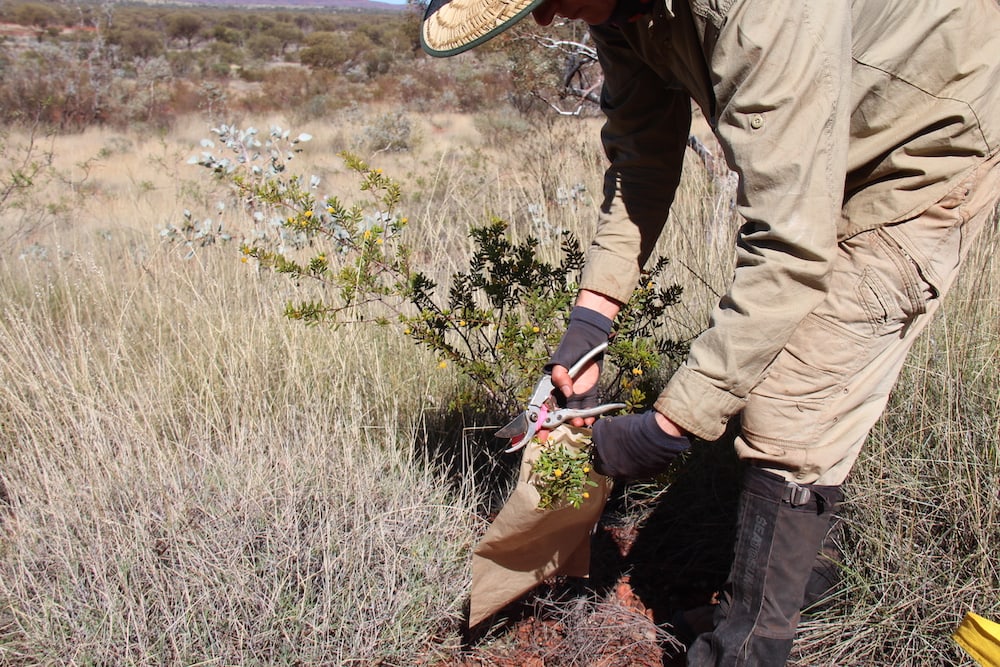Every year our farmers apply many tonnes of expensive fertiliser because Australia’s soils are naturally deficient in phosphorus. To help reduce this reliance on fertiliser, Dr Ashlea Doolette from the University of Adelaide is using TERN plant samples to learn from our ‘phosphorus-efficient’ native plants and develop novel approaches that could save our agricultural industries millions of dollars every year.
Phosphorus is an essential nutrient for all forms of life, especially our food crops. As most of Australia’s soils are deficient in phosphorus so every year our farmers need to add fertiliser to grow healthy crops. There is a critical need to decrease our reliance on phosphorous fertiliser and find alternative methods to improve crop nutrition at the same time.
To help address this complex challenge, Dr Ashlea Doolette from the University of Adelaide is studying the strategies that Australian native plants employ to extract, store and utilise phosphorus from Australia’s nutrient deficient soils.
“We know that Australian native plants survive, and even thrive, on soils that contain very low amounts of phosphorus,” says Ashlea, who is based at The Waite Institute with the university’s School of Agriculture, Food and Wine. “What I’m doing is studying how these native species have adapted and evolved under these conditions, so we can potentially introduce their ‘phosphorus-efficient’ genetic traits into agriculturally important species.”
The first step is to understand the remarkably efficient use of phosphorus in many native species. To do this, Ashlea has accessed the soil and vegetation data and samples TERN collects at hundreds of ecosystem surveillance sites scattered all around the nation.

University of Adelaide researcher Dr Ashlea Doolette is using TERN’s Ecosystem Surveillance data and field samples, including those collected at sites in the Australian Alps (above), to learn from Australia’s phosphorus-efficient native species and develop novel approaches that reduce agriculture’s reliance on phosphorus fertiliser
“Using the TERN data and archived plant samples I’ve been able to target species that are known to adapt to low phosphorus soils,” says Ashlea. “It would require too many samples for me to analyse all species at all TERN’s sites, so I’ve used the data to quickly and easily discover which species occur where. TERN has saved me months of work!”
Focusing on the soil and vegetation data and samples from TERN sites along the Biodiversity Adaptation Transect Sydney, Ashlea has identified several species of phosphorous-efficient eucalypts for further analysis.
“The next step is to sample the identified species at each site to examine the influence of soil phosphorus as well as other environmental factors, such as soil moisture content and organic matter.”
“To do this I’ll use a technique called nuclear magnetic resonance spectroscopy to obtain detailed information on how some of Australia’s native plants have evolved to cope with low phosphorous soils and store and use phosphorous so efficiently. This will then underpin novel approaches that reduce our reliance on phosphorus fertilisation in agricultural systems.”
“Introducing the phosphorus-efficient traits of Australian natives into just a few of our major crops could potentially save our farmers and agricultural industries millions of dollars each year,” says Ashlea.
“There’s a lot of work still to be done but the potential outcomes and on-ground impacts of this TERN-facilitated research are very exciting.”
Keep an eye out in future editions of the TERN eNewsletter for updates on Ashlea’s research and its impact on our agricultural industries.







